20 Life Areas: Strategium Personal Score Test Results Revealed
We appreciate your effort in completing the Strategium Intelligence Quotient (sIQ) test. In this article, we aim to guide you in interpreting your test results.
If you haven’t taken the sIQ test yet, we highly recommend you do so before proceeding. Kindly save your test results and return to this page to gain better clarity.
Table of Contents
Understanding Your Strategium Intelligence Quotient (sIQ)
Upon completion of the test, you will receive the following information with your specific data:
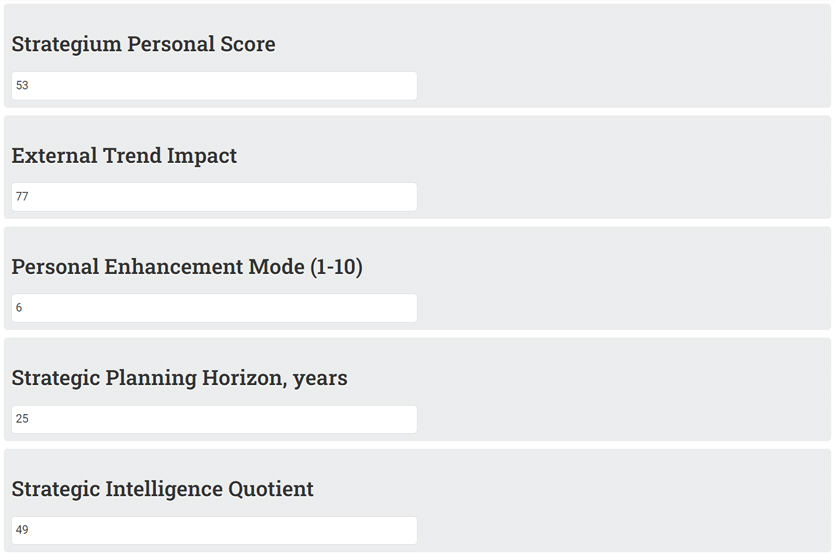
You will find five calculated parameters that comprise your SPS test results:
- Strategium Personal Score (SPS) Showcases your progress in 20 different areas of life.
- External Trend Impact (ETI) Highlights the state and dynamics of your environment and the external trends that may influence your decision-making process.
- Personal Enhancement Mode (PEM) Employs various factors to calculate the most suitable effort intensity level to achieve your goals.
- Strategic Planning Horizon (SPH) Estimates the crucial parameter and recommends the proper strategic planning horizon in years.
- Strategium Intelligence Quotient (sIQ) Integrates all other indicators and displays the level of your strategic development from 0 to 100. Depending on this indicator, you can decide whether or not to develop a personal strategic plan.
You need to understand what they entail to draw sound conclusions and decisions based on these parameters. Let us help you gain better insight into your results.
Understanding Your Strategium Personal Score (SPS)
The Strategium Personal Score (SPS) is an essential parameter that measures your development in 20 different life areas. Understanding your SPS value is crucial in identifying your personal development needs and making decisions based on your test results.
Your SPS ranges from 0 to 100 and reflects your overall personal development and life quality in different areas. It means that values up to 20 correspond to a low level, 20-80 – to an average, and more than 80 – to a high level.
As you know, we have developed an advanced method of achieving goals through strategic analysis and creating a personal strategy. If you want to learn more about this approach, click the link.
It’s important to note that while high SPS scores are desirable, they may also have some ambiguous aspects. To correctly interpret your SPS score, follow these steps:
- Determine your Strategium Personal Score (SPS) from the test results.
- Locate your SPS value on the horizontal axis on the chart below.
- Observe the areas of the chart that correspond to your SPS value: indicated by yellow, red, or green arrows. This information is necessary to make a decision.
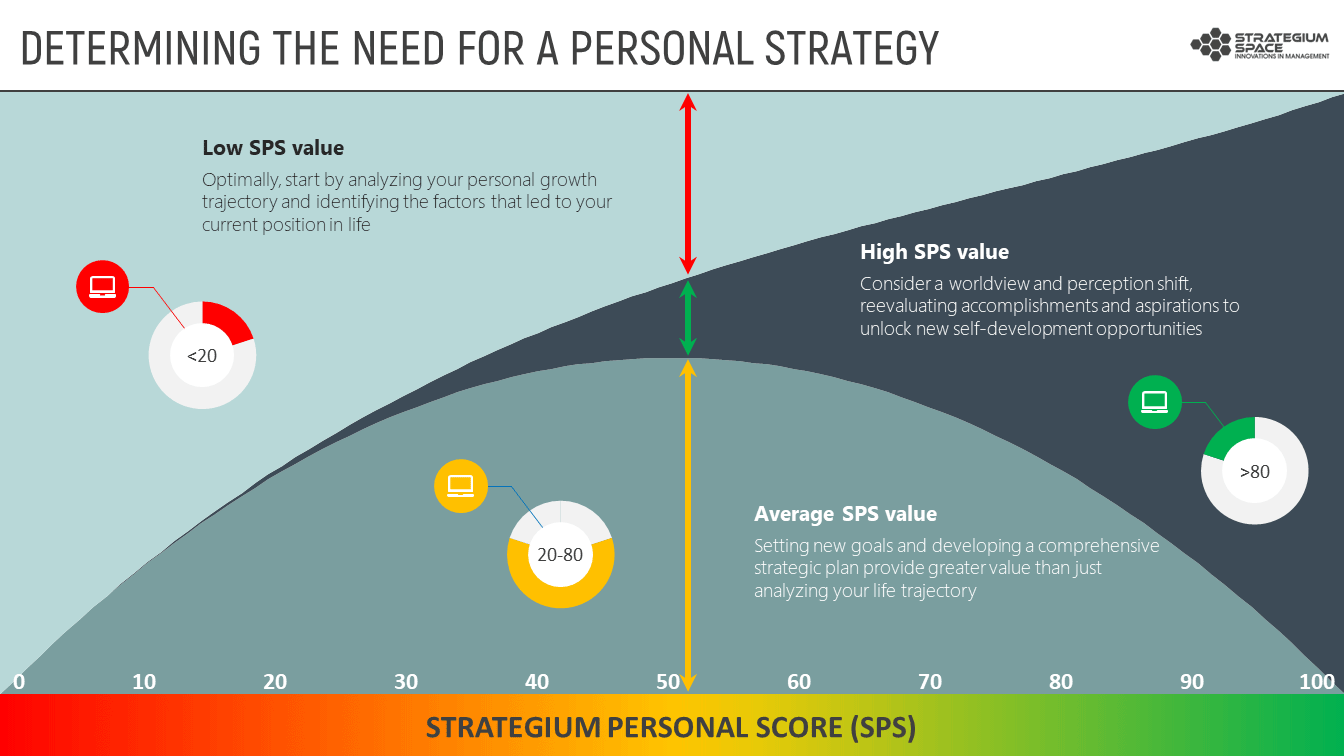
The diagram shows three different areas. Your SPS score corresponds to a specific ratio of these areas. The proportion determines the most preferred approach to your further development.
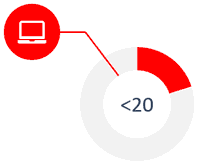 I. Interpreting a Low SPS Value (less than 20)
I. Interpreting a Low SPS Value (less than 20)
When your Strategium Personal Score (SPS) is less than 20, and the red arrow zone predominates, it is not the best time to develop a strategic plan.
Instead, analyze your life path to understand why your SPS value is so low. To help you with this, we recommend taking first two modules of our course.
This program will allow you to outline your future strategy and gain access to a road map, which will help you develop a strategic plan by yourself.
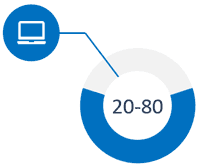 II. Interpreting an Average SPS Value (20 – 80)
II. Interpreting an Average SPS Value (20 – 80)
When your SPS is between 20-80, the yellow arrow zone predominates on the chart above. You can benefit most from developing a comprehensive strategic plan in this situation.
If you have a low SPS, you need to understand the internal and external causes of the situation, then reflect and think about new goals and strategies to achieve them.
However, if your SPS is average, training in Modules 1 and 2 of the course will not be sufficient. You need to understand what new goals to set and, most importantly, develop ways to achieve them.
Without a plan, your goals are just notes for Santa Claus. This task corresponds to our entire personal strategic planning course.
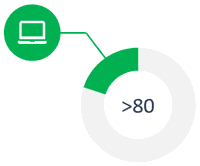 III. Interpreting a High SPS Value (over 80)
III. Interpreting a High SPS Value (over 80)
If your SPS is over 80, and you are in the green arrow area of the chart, it means that you have achieved excellent test results but may not set ambitious goals.
High quality of life is good, but it may slow your development. Therefore, you need to analyze your situation and see if you have a low-ambition problem.
Let’s assume that the problem does exist. In that scenario, you can consult psychologists to restart your perspective and shift your perception of the world. This work may include reassessing your achievements and claims.
When you understand that there is something to strive for and open up new horizons for growth and self-development, we recommend returning to the entire personal strategy program.
If you have any questions or ambiguities about this interpretation of your SPS value, please, don’t hesitate to contact us for clarification.
Understanding the Impact of External Trends (ETI)
The External Trend Impact (ETI) metric measures the state and dynamics of your environment, including the external trends that may influence your decision-making process. This metric is calculated using your data and considers your environment’s current state and prospects. A high ETI coefficient indicates the presence of dangerous trends in your external environment, making it critical for you to develop a personal strategic plan.
For instance, suppose your SPS score is 60. In that case, developing a personal strategy may seem optional. On the other hand, imagine that your External Trend Impact is more than twoб which implies that you are under pressure from disruptive factors and trends in the external environment. These negative factors could include problems in the industry you work in, your profession, and your place of residence, which may be degrading. Therefore, the need to develop a personal strategic plan increases considerably in such circumstances.
The conclusion is straightforward: developing a personal strategic recovery plan becomes imperative if the dynamics of your industry, profession, and environment are dangerous to your future. By doing so, you can try to overcome the dangers and challenges posed by your external environment and improve the chances of your future success. If you have any questions about the ETI metric, please do not hesitate to contact us for further clarification.
Understanding Personal Enhancement Mode (PEM)
Personal Enhancement Mode (PEM) is a recommended efforts level to achieve personal growth and transform one’s life. The PEM metric considers various factors to determine the right intensity of effort required to achieve your goals.
The first level of Personal Enhancement Mode implies no significant effort toward strategic transformation. However, the tenth mode requires one to devote all their time to achieving strategic goals, irrespective of daily activities and current tasks.
Levels three and above require a strategic analysis of the situation, advanced goal-setting, and long-term planning to achieve strategic goals. Therefore, if the SPS test results recommend Personal Enhancement Modes three and above, engaging in personal strategic planning is critical for achieving your goals.
Personal Enhancement Mode also applies when defining the thinking or planning horizon. To learn more about PEM, you can refer to the next chapter.
Understanding Strategic Planning Horizon (SPH)
The Strategic Planning Horizon (SPH) is a critical parameter that estimates the appropriate time horizon for developing a strategic plan. We recommend that you base your strategy on this time horizon.
The strategic planning horizon closely correlates with the thinking horizon. To clarify, the time horizon for thinking refers to the ability to analyze and make decisions within a specific timeframe. The time frame for analyzing the external environment and developing your plan should match your strategic planning horizon.
By expanding your planning horizon, you also extend your thinking horizon. Developing a strategy, making important decisions, and choosing your path requires a significant intellectual effort that contributes to expanding your strategic and systemic thinking.
For instance, if you create a five-year plan, you inevitably extend the time horizon of your thinking to five years. Thus, developing a strategic plan can efficiently cultivate strategic thinking and broaden your intellectual horizons.
Understanding Strata and Its Relevance to Your Test Results
In today’s discussion, we will also explore the concept of strata, which refers to the different levels of organizational hierarchy introduced by Elliot Jaques in 1963. Each stratum requires a specific time horizon of thinking, depending on the nature of the activity.
The simplified distribution of society by strata includes:
- Unskilled workers who perform standard operations.
- Skilled workers, specialists, and low-level managers.
- Mid-level managers and heads of small businesses and non-profit organizations.
- Leaders of medium-sized commercial and non-profit organizations.
- Directors of large commercial and non-profit organizations.
- Heads of international corporations, organizations, and industries.
- State leaders, global leaders, sages, and prophets.
The illustration below shows an example.
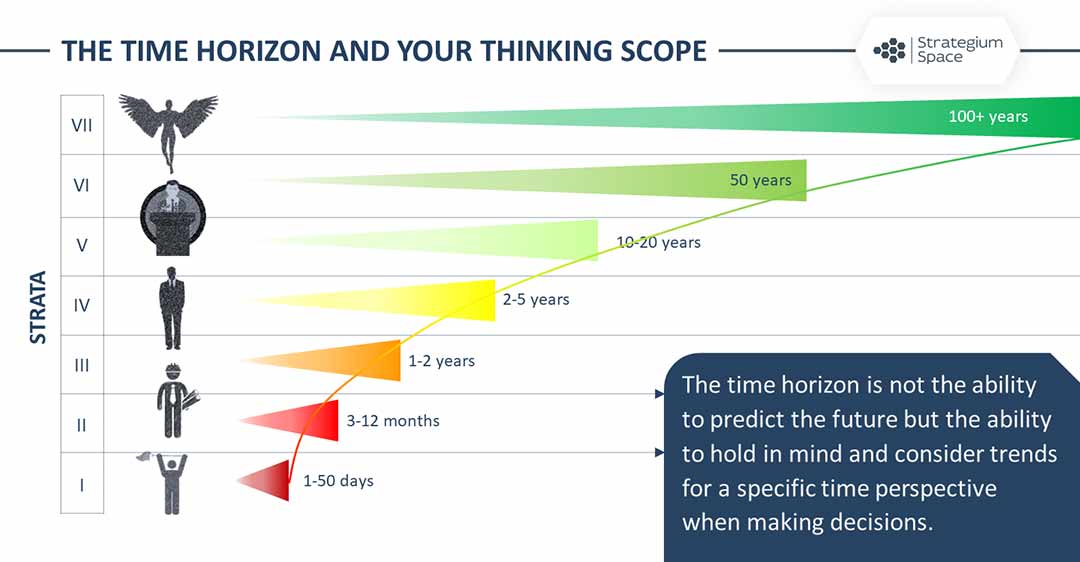
It is undeniable that everyone belongs to one of these strata. However, it is indisputable that not everyone is happy with their current belonging to a particular stratum. Many go out of their way to raise their strata. Some believe that hard work ensures success; others think you need better reasons and more clever approaches. Let’s explore actionable strategies that individuals like you and me can implement to enhance our stratum.
Selecting the Appropriate Stratum and Personal Enhancement Mode Aligned with Your Goals and Life Stage
Everyone understands that one’s life path is not equivalent to their career trajectory in an organization. However, humans are social creatures, and we can use the concept of strata to plan our lives effectively. The principle of the scale of thinking presented in Elliot Jaques’ study “Human Capabilities” is demonstrated in the diagram below. Please, note that the SPS test results algorithm calculates your planning horizon based on PEM #8. If you want to define your Strategic Planning Horizon based on individual Enhancement Mode, use the instruction below. To define the appropriate time frame for developing your strategic plan, consider Personal Enhancement Mode. Look at the graph above. You can see that the horizontal axis represents your age, while the vertical axis combines two dimensions: the time horizon of thinking and the strata.
Determining the Right Thinking Horizon with Your Test results
To determine your thinking horizon, follow these steps:
- Firstly, locate your age on the horizontal axis of the chart. The graph shows the relationship between age and horizon of thinking, based on the research conducted by Elliot Jaques in “Human Capabilities” (1963). For example, let’s assume you are 40 years old.
- Next, draw a vertical line from the point on the horizontal axis corresponding to your age.
- Then, choose Personal Enhancement Mode from 1 to 10 comfortable for you. Each mode reflects different levels of self-development, with mode 1 requiring minimal effort and mode 10 involving a total focus on goal attainment, excluding all unrelated activities. Let’s assume you compromise on medium development mode #5.
- Draw a horizontal line from the intersection of your age and the chosen development mode to the left-hand axis to determine the required thinking horizon. For example, for a 40-year-old person in Personal Enhancement Mode #5, the graph shows the recommended planning horizon of two years.
- Identify the stratum corresponding to your calculated thinking horizon using the second scale on the left. In this example, the third stratum corresponds to a two-year thinking horizon.
- Compare your desired stratum to your current one and adjust the planning horizon accordingly.
If your stratum is higher than the calculated one, you have chosen a less ambitious approach to your goals. In that case, you should adjust the mode upward unless you intentionally prefer a reduced pace and workload.
How to Make a Quantum Leap to Higher Strata with a Personal Strategy
To make a significant leap to a higher stratum, you must first choose the stratum you want to belong to. If your desired level is higher than your current one, adjust your scale of thinking accordingly.
For example, let’s say you currently belong to stratum #3 and want to belong to stratum #6. In this case, you need to choose a thinking horizon of 15-20 years instead of the 2-year horizon you previously calculated.
But how can you make such a quantum leap in self-awareness?
The answer lies in developing a personal strategy – a strategic plan tailored to your goals for the next 15-20 years. The graph above shows that achieving your desired level will require you to switch to full-throttle Personal Enhancement Mode (8 and above).
You can find additional guidance in Personal Strategy Course.
Understanding Strategic Intelligence Quotient (sIQ)
As you can see from the test results, there is another calculated indicator to consider. This indicator is integral and depends on the previous four calculations. It summarises and reflects the extent to which you may need to develop a personal strategy.
If your test results indicate:
- Low Strategium Personal Score (SPS).
- High External Trend Impact (ETI).
- High Personal Enhancement Mode (PEM).
- High Strategic Planning Horizon (SPH).
Then your sIQ is minimum. In other words, it is essential to start developing a strategy as soon as possible.
Why you may need to develop a personal strategy?
First and foremost, it will help you achieve your goals. Without a strategic plan, you will lack direction and may waste your time and effort. With a strategy, you can prioritize your goals and align your actions and everyday life with them.
Secondly, a personal strategy can help you anticipate and overcome barriers. Life is unpredictable, and challenges can arise at any time. A personal strategic plan can help you prepare for these challenges by identifying potential obstacles and creating a plan to overcome them.
Thirdly, a personal strategy can help you stay motivated. Developing a strategic plan requires reflecting on your values, strengths, and weaknesses. This reflection can help you clarify your purpose and increase your motivation to achieve goals.
So, what does a personal strategy entail?
The Personal Strategy Development Course helps you create a comprehensive strategy tailored to your unique situation. The program includes the following steps.

However, before starting, you go through a few lessons dedicated to an in-depth strategic analysis of your personality.
In conclusion, developing a personal strategy is critical to achieving your goals, overcoming obstacles, and staying motivated. If your test results indicate a low sIQ, consider enrolling in the Personal Strategy Development Course to gain the necessary skills and knowledge to create a comprehensive strategy tailored to your unique situation.
Feel free to inquire about any ongoing promotions for this course. We are always ready to assist and consider your situation.
Do it strategically!
Количество слов в этой статье: 2391
 ©Deem Rytsev - the author is the founder of Strategium.Space and NooSphereum.Org and specializes in strategic management in his scientific and business activities.
©Deem Rytsev - the author is the founder of Strategium.Space and NooSphereum.Org and specializes in strategic management in his scientific and business activities.↓ If you liked the article, don't forget to share ↓

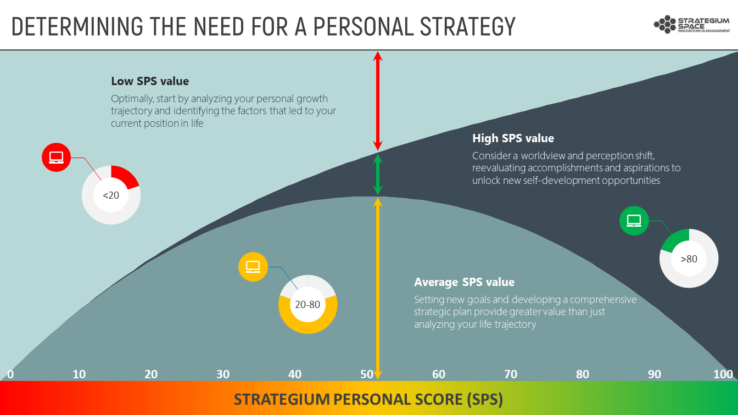
Comments